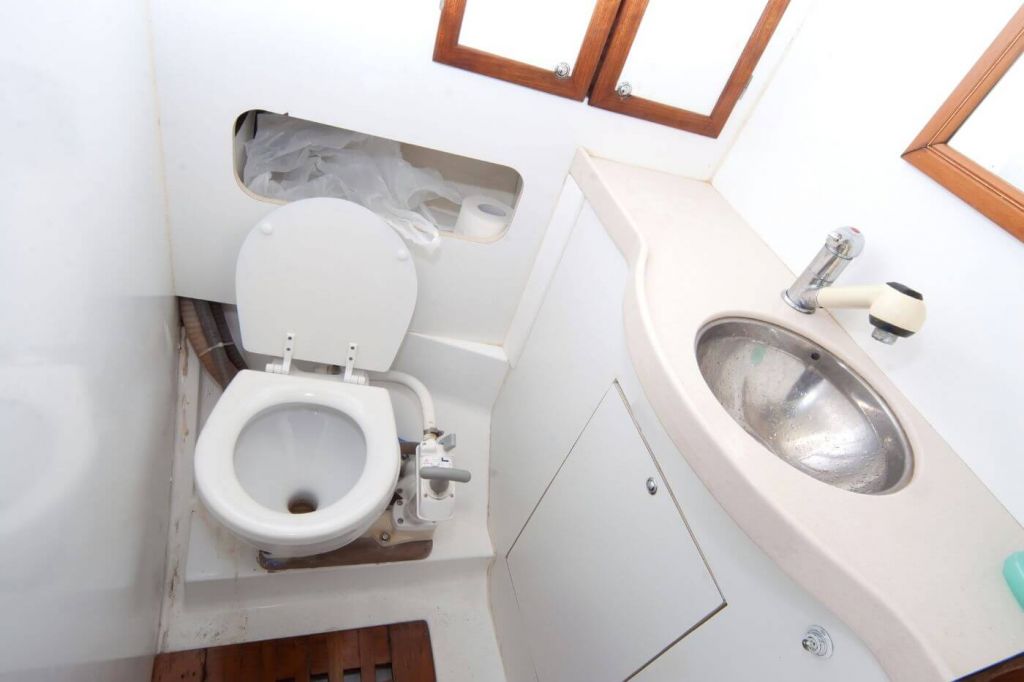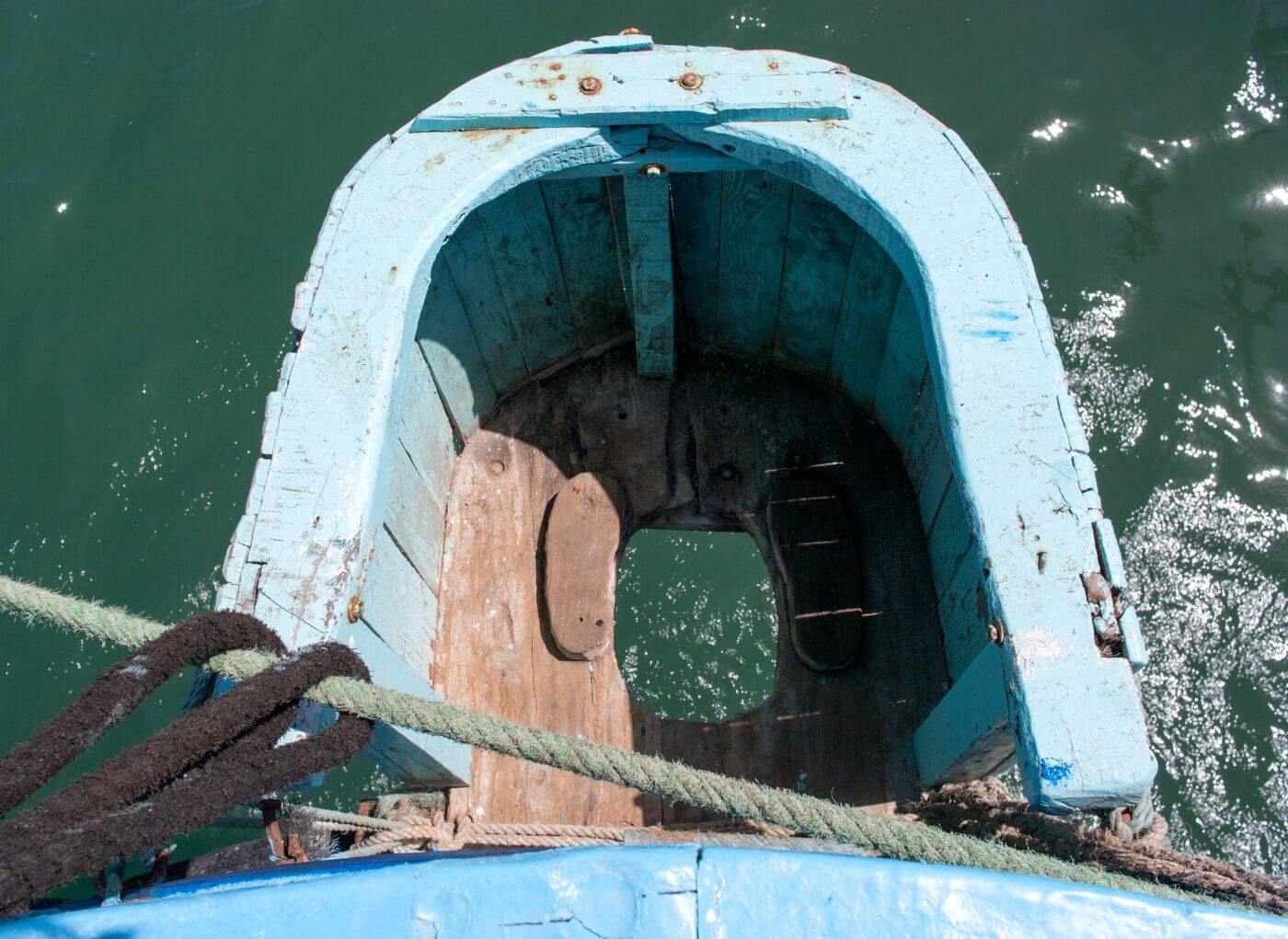How Much Water Does A Marine Toilet Use?
Marine toilets are a luxury that many boaters can’t imagine going without, but the water usage for marine toilets can be very high. To find out how much water a marine toilet uses, you first need to know what type of toilet it is.
How much water does a marine toilet use? Water usage for marine toilets can generally range from 0.4 liters to 3.5 liters per use, depending on the model and the complexity of the system. The most economical marine toilets are simple cassette toilets and VacuFlush systems. Alternatively, compostable and incineration toilets use zero water to process waste.
Read on to find out more about water and marine toilets, as well as how to limit your water consumption on board to avoid flushing money down the drain.

The Amount of Water Depends on the Type of Marine Toilet
When calculating water consumption for marine toilets, you need to take into account what type of toilet you are installing.
If you opt for an integrated cassette toilet, the water will come from the water system on your boat. On the other hand, a freestanding cassette toilet holds water in the upper part of the structure. This means that freestanding cassette toilets tend to be more economical in their water usage than integrated models and they are also more mobile.
Here are different marine toilets ranked least water consumption to highest water consumption:
- Composting & incinerating marine toilets: no water
- Vacuum flush toilets: 0.4 - 1 liter
- Electric toilets: 1-2 liters
- Manual toilets: up to 3.5 liters
Manual Toilets Consume More Water
Manual toilets use a hand pump for the flush function, pumping out waste and pumping in fresh water. Whilst they are generally more affordable than electric toilets, when it comes to water consumption they can be more wasteful. This is because it can be difficult to control water usage, especially if you have children or guests using the toilet whilst on board.
There is a danger that first-timers will pump more water than is needed. Not only does this use up more fresh water, but it also fills your storage tank faster. Too much pumping means too much water is flushed, which means more emptying for you!

Electric Toilets Tend to Be More Economical
Unlike manual flush toilets, electric marine toilets flush automatically. This means that the amount of water used for each flush is controlled and fixed. As a result, they are more predictable and often more frugal with the amount of water they consume. Eco-flushing designs are often especially good at conserving water, so these are usually your best bet for limiting water consumption.
The flip side is that an electric toilet uses a lot more power than a manual toilet and they are not practical for smaller boats. This is something that is worth factoring into your calculations when choosing the best toilet for your needs.
Vacuum Flush Toilets are the Best
Even more efficient that electric toilets are vacuum flush toilets. This is because vacuum flush toilets rely on pressure to flush waste, rather than water.
By manipulating the pressure in the system and creating a vacuum, waste gets sucked out of the toilet, minimizing the need for water to flush. The system also clears completely with every flush, dramatically reducing the risk of odors that are common with most water flushing toilets. VacuFlush toilets typically only use about 0.4 to 1 liters of water, depending on how long you press the flush for, putting them at the top of the list for lowest water consumption.
What’s a Compostable Marine Toilet?
Another option to dramatically reduce the water consumption of your marine toilet is to opt for a composting toilet instead. Composting toilets separate liquids and solids and store them separately. They then use a drying material like sawdust or peat moss to process solid waste. The drying action minimizes the smell of the waste, without the need for intensive and environmentally-damaging chemicals.
Thanks to the composting effect, composting toilets don’t require any water to function and are very low maintenance. With a composting toilet, you don’t need to worry about blockages like you do in traditional water-based systems. Like the name suggests, the converted waste is all compostable and can be used as fertilizer. The liquids must be disposed of separately on land, but as they don’t contain any chemicals, they do not need to be deposited at a specialist facility.
What’s an Incinerating Marine Toilet?
Like the composting toilet, incinerating marine toilets don’t require any water to function. Incinerating marine toilets use heat to dispose of waste. The waste is burned in a sealed incineration chamber, and the gases are released through a ventilation pipe.
The incinerating action converts the waste into odorless ash, reducing waste to approximately one cup of ash per person per week, which can then be used as fertilizer. Incineration toilets negate the need for water or specialist waste disposal facilities. They get rid of waste without storing it in tanks or using a pump-out system. This means that you don’t need to worry about smell like you do with marine toilets that use water. That being said, some people report that there can be a lingering burnt smell.
The major drawback of an incinerating toilet is its electricity consumption. Whilst it doesn’t use any water, it uses significant amounts of electricity. This can be a major drain for most boats which makes incinerating toilets impractical in many cases.
How to Limit the Water Consumption of Your Marine toilet
To minimize the amount of water your marine toilet uses on board, there are a few key habits that you should try to incorporate into your routine.
Flush sparingly
Whilst this is not the nicest option, your water usage will increase depending on the frequency with which you flush your marine toilet. If you want to reduce your water consumption, one of the easiest ways to do this is to reduce how often you flush. That’s why many boaters recommend not flushing pee only poop. This will make your water go further. You’ll just have to learn to deal with a not so picturesque toilet scene.
Use onshore facilities
Another simple way to reduce the water consumption of your marine toilet is to avoid using it whenever possible! That doesn’t mean you have to cross your legs throughout the day, but it does mean making use of onshore facilities when you get the opportunity.
No matter how much you might enjoy the novelty and privacy of going on your own boat, in terms of water consumption, it makes much more sense to use onshore facilities whenever you can. Don’t fall into the trap of preferring your boat over the clubhouse, that’s a sure route to maximum water consumption, not to mention maximum trips to empty the tank.
Help guests understand your toilet
This is one of the stranger subheadings I’ve written in my career, but it is also an important one! Don’t forget that guests staying on board your boat might not be as intimately acquainted with the ins and outs of marine toilet ownership as you are!
With this in mind, make sure you talk any guests through the do’s and don’ts of using the toilet to help prevent any embarrassing blockages. You should also politely ask them to limit their flushing wherever possible to help reduce their water consumption. This is especially important if you have a manual toilet as first-timers might over use the pump.
Rinse the tank but don’t fill it to the top
The easiest way to reduce odor is to keep your waste holding tank empty. If waste is allowed to sit for a long time, it will create odor that will spread through your boat. To avoid this, it is a good idea to empty and flush your tank often with freshwater. However, you don’t need to fill the tank completely when flushing. To save water and flush your tank effectively, just fill it about a quarter of the way up before pumping it out.
A quarter full is all that’s needed to flush out the sediment gathered at the bottom of the tank. You can repeat this two or three times to make sure the tank is clean and it will still use less water than filling the tank to the top.
Marine Toilets and Water Usage
The total water consumption of your marine toilet will depend on the type of toilet you opt for. Some models can be extremely water efficient and some even use no water at all. On the other hand, elaborate designs that aim to mimic the experience of a toilet on land tend to use water far more liberally. You can help to reduce the water consumption of your toilet by flushing less regularly and encouraging your guests to do the same.
Did you find the answer to your specific question?
👍 3 👎 2
Comments
Mark David
I wamt to replace the toilet on my 36 ft. Class A motor home with a manual flush Jabsco marine toilet. The reason is to better control smell. I have 84 gal of fresh water on board, so water usage isn’t an issue. What say you? Thanks
Leave a comment